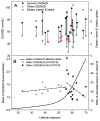Biologically efficient solar radiation: Vitamin D production and induction of cutaneous malignant melanoma
- PMID: 24494048
- PMCID: PMC3897583
- DOI: 10.4161/derm.22941
Biologically efficient solar radiation: Vitamin D production and induction of cutaneous malignant melanoma
Abstract
Solar ultraviolet (UV) radiation is the main source of vitamin D production and is also the most important environmental risk factor for cutaneous malignant melanoma (CMM) development. In the present study the relationships between daily or seasonal UV radiation doses and vitamin D status, dietary vitamin D intake and CMM incidence rates at different geographical latitudes were investigated. North-South gradients of 25-hydroxyvitamin D (25(OH)D) generation and CMM induction were calculated, based on known action spectra, and compared with measured vitamin D levels and incidence rates of CMM. The relative roles of UVA and UVB in CMM induction are discussed. Latitudinal dependencies of serum 25(OH)D levels and CMM incidence rates can only partly be explained by ambient UV doses. The UV sensitivity is different among populations with different skin color. This is well known for CMM, but seems also to be true for vitamin D status. The fact that UV-induced vitamin D may reduce the risk of CMM complicates the discussion. To some extent high dietary vitamin D intake seems to compensate low UV doses.
Keywords: UVA and UVB ratio; cutaneous malignant melanoma; photoimmunosuppression; solar ultraviolet radiation; vitamin D.
Figures





Similar articles
-
UVA, UVB and incidence of cutaneous malignant melanoma in Norway and Sweden.Photochem Photobiol Sci. 2012 Jan;11(1):191-8. doi: 10.1039/c1pp05215b. Epub 2011 Oct 11. Photochem Photobiol Sci. 2012. PMID: 21986949
-
Daily, seasonal, and latitudinal variations in solar ultraviolet A and B radiation in relation to vitamin D production and risk for skin cancer.Int J Dermatol. 2016 Jan;55(1):e23-8. doi: 10.1111/ijd.13065. Epub 2015 Nov 6. Int J Dermatol. 2016. PMID: 26547141
-
North-South gradients of melanomas and non-melanomas: A role of vitamin D?Dermatoendocrinol. 2013 Jan 1;5(1):186-91. doi: 10.4161/derm.23791. Dermatoendocrinol. 2013. PMID: 24494053 Free PMC article.
-
Ultraviolet radiation and malignant melanoma.Adv Exp Med Biol. 2008;624:104-16. doi: 10.1007/978-0-387-77574-6_9. Adv Exp Med Biol. 2008. PMID: 18348451 Review.
-
Ultraviolet radiation and cutaneous malignant melanoma.Adv Exp Med Biol. 2014;810:359-74. doi: 10.1007/978-1-4939-0437-2_20. Adv Exp Med Biol. 2014. PMID: 25207376 Review.
Cited by
-
Role of Vitamin D Metabolism and Activity on Carcinogenesis.Oncol Res. 2014;22(3):129-37. doi: 10.3727/096504015X14267282610894. Oncol Res. 2014. PMID: 26168131 Free PMC article. Review.
-
Seasonal Vitamin D Status in Polish Elite Athletes in Relation to Sun Exposure and Oral Supplementation.PLoS One. 2016 Oct 12;11(10):e0164395. doi: 10.1371/journal.pone.0164395. eCollection 2016. PLoS One. 2016. PMID: 27732653 Free PMC article.
-
Low Cloud Cover-Adjusted Ultraviolet B Irradiance Is Associated with High Incidence Rates of Leukemia: Study of 172 Countries.PLoS One. 2015 Dec 4;10(12):e0144308. doi: 10.1371/journal.pone.0144308. eCollection 2015. PLoS One. 2015. PMID: 26637119 Free PMC article.
-
Autumn COVID-19 surge dates in Europe correlated to latitudes, not to temperature-humidity, pointing to vitamin D as contributing factor.Sci Rep. 2021 Jan 21;11(1):1981. doi: 10.1038/s41598-021-81419-w. Sci Rep. 2021. PMID: 33479261 Free PMC article.
References
-
- Rosso S, Zanetti R, Martinez C, Tormo MJ, Schraub S, Sancho-Garnier H, et al. The multicentre south European study ‘Helios’. II: Different sun exposure patterns in the aetiology of basal cell and squamous cell carcinomas of the skin. Br J Cancer. 1996;73:1447–54. doi: 10.1038/bjc.1996.275. - DOI - PMC - PubMed
LinkOut - more resources
Full Text Sources
Other Literature Sources
